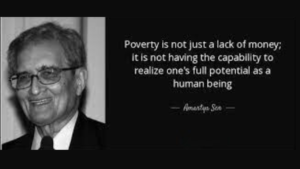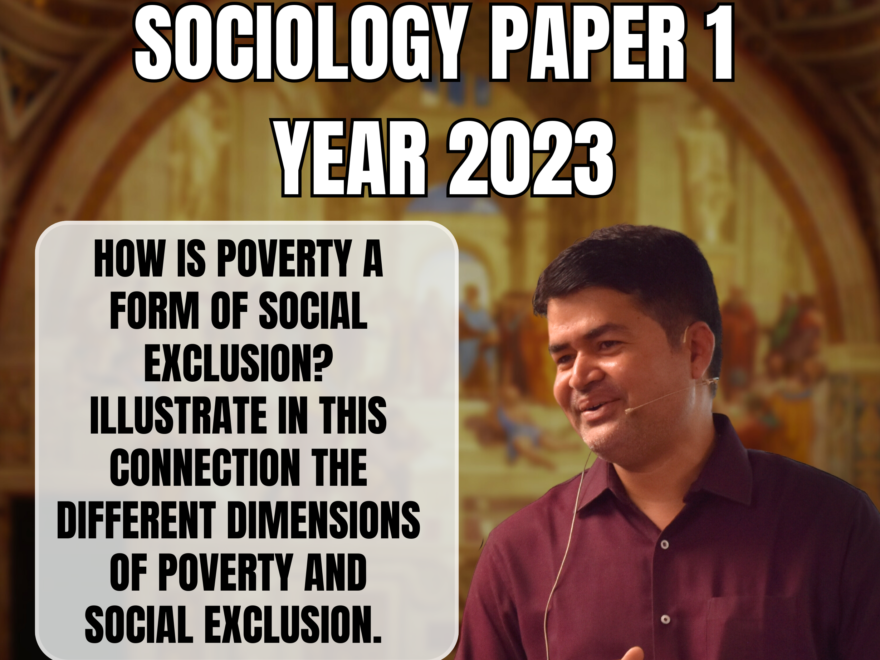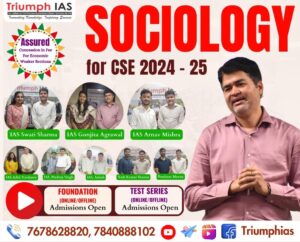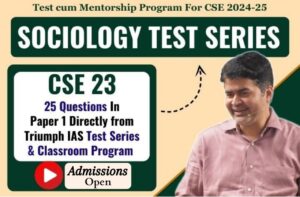How is poverty a form of social exclusion? Illustrate in this connection the different dimensions of poverty and social exclusion.
Section: A.
Sociology Paper 2023 Analysis.
Relevant for Paper 1: Unit 5 Stratification and Mobility; Exclusion, Poverty

Question 4 (b): How is poverty a form of social exclusion? Illustrate in this connection the different dimensions of poverty and social exclusion.
(20 Marks)
|
Introduction: Brief About the Meaning of Terms Poverty and Social Exclusion. Main Body: Explain Poverty as a Form of Social Exclusion in Terms of Economic , Social, Cultural , Political Dimensions and also in Brief Explore how Social Exclusion also Leads Poverty Conclusion: Breaking Viscous Cycle of Poverty and Social Exclusion using Intervention Based on Amartaya Sen Capability Approach ; Antodaya; Social Economic and Political Justice. |
Introduction:
Poverty and social exclusion are two interrelated concepts that are often used together. Poverty refers to a lack of resources, while social exclusion refers to the inability of individuals or groups to participate fully in society due to various factors such as poverty, discrimination, and marginalization. Poverty is a form of social exclusion because it prevents individuals from accessing basic resources and opportunities that are necessary for full participation in society.
Main body:
- Economic Dimension Poverty can be seen as a form of social exclusion in several ways. Firstly, the poor are often excluded from the economic system, as they lack the resources to participate fully in the market economy. They are unable to afford basic necessities, such as food, clothing, and shelter, and are often denied access to opportunities for employment and income generation. This economic exclusion often results in social exclusion, as the poor are marginalised and stigmatised in society.
-
- For instance : Gated communities and nearby slums epitomize stark cultural disparities. Within these enclaves, household staff and gatekeepers often reflect this divide, navigating separate lifts and stairs. This physical segregation underscores how poverty remains a potent force in perpetuating social exclusion.
-
- Anthony Giddens argues that Homelessness is the worst form of social exclusion. They are often excluded from the economic system (unable to afford housing), the political system (their voices and interests are often ignored), social networks (they are often isolated and stigmatised), and the dominant culture (their situation is often blamed on their own personal failings, rather than structural inequalities).
- Exclusion from Essential Capabilities and Freedoms: Amartya Sen’s capability approach emphasizes that poverty is not solely the absence of income; it is the exclusion from of essential capabilities and freedoms. Poverty restricts individuals from participating fully in the market economy, limiting their life choices, life chances and opportunities.
Eg. Andre Beteille in his study of Sripuram Village found that lower class samarthas( Brahmins) were largely excluded by upper class samarthas and Sri vaishnavas.
- Political Dimension: Poverty often results in political exclusion, where the impoverished have limited access to political processes. They are unable to influence decisions and policies that directly affect their lives. This exclusion further exacerbates their economic and social marginalization, creating a cycle of disadvantage.
-
- “Low-income migrants often find themselves overlooked by both the political elites at their place of origin and their destination, as they are often excluded from the rights of voting and running for office.
-
- Lack of social capital : Social exclusion encompasses not only economic disparities but also the absence of robust social networks and relationships. Robert Putnam’s concept of social capital underscores the significance of these networks in achieving social inclusion. For individuals grappling with poverty, social exclusion often results in isolation and a dearth of essential social support. This social exclusion can lead to a sense of hopelessness and despair, further deepening their poverty.
- Cultural Dimension: Pierre Bourdieu’s concept of “symbolic violence“ highlights the cultural dimension of poverty and social exclusion. Symbolic violence refers to the way in which the dominant culture stigmatizes and marginalizes the impoverished, blaming them for their situation rather than acknowledging the structural factors contributing to their poverty. This cultural norm and stereotype can lead to the exclusion of the impoverished from resources and opportunities.
- Not only has the poverty led to social exclusion but social exclusion creates multiple deprivations leading to poverty. Feminisation of poverty is a phenomenon illustrating how prolonged exclusion culminating into poverty, not only economic, but social and political too.
Conclusion:
To break the vicious cycle of poverty and social exclusion, it is important to adopt a multidimensional approach that takes into account the different dimensions of poverty and social exclusion. Amartya Sen’s capability approach emphasizes the importance of expanding people’s capabilities to live the lives they value, “Antodaya,” which means “rising of the poorest,” is a concept that emphasizes the need to focus on the poorest and most marginalized sections of society can help us to solve the issue of poverty and social exclusion. Social, economic, and political justice are also important in addressing poverty and social exclusion.
Related Blogs…
 |
 |

To master these intricacies and fare well in the Sociology Optional Syllabus, aspiring sociologists might benefit from guidance by the Best Sociology Optional Teacher and participation in the Best Sociology Optional Coaching. These avenues provide comprehensive assistance, ensuring a solid understanding of sociology’s diverse methodologies and techniques.
META TAGS:
Iron Law of Oligarchy, Robert Michels, Vilfredo Pareto, Lions and Foxes theory, power dynamics, organizational oligarchy, elite circulation, political sociology, leadership styles, organizational control, sociological theories, political maneuvering, elite differentiation, power concentration, societal stability, political leadership, strategic political leadership, Sociology Question Paper, Sociology Question Paper 2023, Sociology Question Paper CYQ, Sociology Question Paper UPSC, What, according to Robert Michels, is the iron law of oligarchy? Do lions and foxes in Vilfredo Pareto’s theory, essentially differ from each other? Substantiate.
Why Vikash Ranjan’s Classes for Sociology?
Proper guidance and assistance are required to learn the skill of interlinking current happenings with the conventional topics. VIKASH RANJAN SIR at TRIUMPH IAS guides students according to the Recent Trends of UPSC, making him the Best Sociology Teacher for Sociology Optional UPSC.
At Triumph IAS, the Best Sociology Optional Coaching platform, we not only provide the best study material and applied classes for Sociology for IAS but also conduct regular assignments and class tests to assess candidates’ writing skills and understanding of the subject.
Choose The Best Sociology Optional Teacher for IAS Preparation?
At the beginning of the journey for Civil Services Examination preparation, many students face a pivotal decision – selecting their optional subject. Questions such as “which optional subject is the best?” and “which optional subject is the most scoring?” frequently come to mind. Choosing the right optional subject, like choosing the best sociology optional teacher, is a subjective yet vital step that requires a thoughtful decision based on facts. A misstep in this crucial decision can indeed prove disastrous.
Ever since the exam pattern was revamped in 2013, the UPSC has eliminated the need for a second optional subject. Now, candidates have to choose only one optional subject for the UPSC Mains, which has two papers of 250 marks each. One of the compelling choices for many has been the sociology optional. However, it’s strongly advised to decide on your optional subject for mains well ahead of time to get sufficient time to complete the syllabus. After all, most students score similarly in General Studies Papers; it’s the score in the optional subject & essay that contributes significantly to the final selection.
“A sound strategy does not rely solely on the popular
Opinion of toppers or famous YouTubers cum teachers.”
It requires understanding one’s ability, interest, and the relevance of the subject, not just for the exam but also for life in general. Hence, when selecting the best sociology teacher, one must consider the usefulness of sociology optional coaching in General Studies, Essay, and Personality Test.
The choice of the optional subject should be based on objective criteria, such as the nature, scope, and size of the syllabus, uniformity and stability in the question pattern, relevance of the syllabic content in daily life in society, and the availability of study material and guidance. For example, choosing the best sociology optional coaching can ensure access to top-quality study materials and experienced teachers. Always remember, the approach of the UPSC optional subject differs from your academic studies of subjects. Therefore, before settling for sociology optional, you need to analyze the syllabus, previous years’ pattern, subject requirements (be it ideal, visionary, numerical, conceptual theoretical), and your comfort level with the subject.
This decision marks a critical point in your UPSC – CSE journey, potentially determining your success in a career in IAS/Civil Services. Therefore, it’s crucial to choose wisely, whether it’s the optional subject or the best sociology optional teacher. Always base your decision on accurate facts, and never let your emotional biases guide your choices. After all, the search for the best sociology optional coaching is about finding the perfect fit for your unique academic needs and aspirations.
Follow us :
🔎 https://www.instagram.com/triumphias
🔎 https://www.youtube.com/c/TriumphIAS
🔎 https://t.me/VikashRanjanSociology
Find More Blogs…
| Compare and contrast Karl Marx’s and Max weber’s | Karl Marx- Historical Materialism |
| Position of Women In the Modern Indian Society | Sociology: Social system and pattern variables |
KEYWORD: dimensions of poverty and social exclusion, dimensions of poverty and social exclusion, dimensions of poverty and social exclusion, dimensions of poverty and social exclusion, dimensions of poverty and social exclusion, dimensions of poverty and social exclusion, dimensions of poverty and social exclusion, dimensions of poverty and social exclusion, dimensions of poverty and social exclusion, dimensions of poverty and social exclusion, dimensions of poverty and social exclusion, dimensions of poverty and social exclusion, dimensions of poverty and social exclusion



